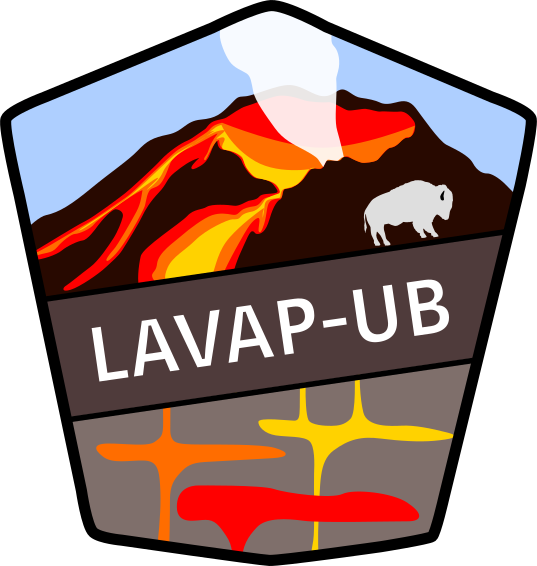The LAVAP-UB team is based at the University at Buffalo and works closely with other researchers and collaborators across the globe. We combine volcanological expertise in synergy with a material science approach to geology using world class experimental facilities.
Dr. Stephan Kolzenburg

Stephan’s research interests lie in the pursuit of topical and important questions in the field of volcanology, natural-hazards, tectonics and material-sciences. He combines a strong experimental background with a passion for applied field and remote-sensing studies. During his research career he has applied his multidisciplinary skillset in physical property based experimental- and field-investigations to characterize a range of processes related to the fluid- and rock-mechanics of volcanoes and other geo-materials. Stephan strives to answer questions posed by field relations via a combined approach of field- and laboratory-studies as well as systematic geo-material-characterization. This allows for the deduction of the processes guiding physical properties and to constrain the timescales of their evolution.
Stephan graduated from the Ludwig-Maximilians University in Munich in 2010 with a B.Sc. in Geosciences; from the University of British Columbia in Vancouver in 2013 with an M.Sc. in Geology; and from the University of Torino in 2016 with a PhD in Earth sciences. Following that he held a Marie Skłodowska Curie global fellowship – project DYNAVOLC. Since 2021 Stephan is an Assistant Professor at the Geology department of the University at Buffalo and lead PI of the LAboratory for experimental Volcanology And Petrology at UB (LAVAP-UB).
Current graduate students
Émilie Saucier

Émilie graduated from McGill University in 2021 with a B.Sc. in Honors Geology and from Penn State in 2023 with a M.Sc. in Geosciences. Her previous research includes studies of the vesicularity of the 1724 phreatomagmatic eruption of Viti, Krafla in Iceland, and a multiparameter study of the 2010-2022 volcanic activity of Telica volcano, Nicaragua. She investigated Telica’s phreatic to phreatomagmatic eruptions and transition from an open to closed system, through modeling, geodetic, thermal, and degassing studies.
For her doctoral studies, Émilie focuses on changes in permeability and degassing patterns of active volcanoes.
Jenna Diamico
Jenna graduated from the University of Rochester in 2022 with a B.S. in Geomechanics. Their previous research includes testing an experimentally-calibrated apatite saturation thermometer on eruptive products from the Augustine volcano in Alaska. As part of their Masters studies, Jenna will work to optimize a computational lava flow model using experimentally determined flow laws integrated with satellite derived vent localization strategies.
Martin Harris
 Martin attended the University of Oregon for his Undergraduate studies earning a Bachelor’s Degree in Science (BSc) in 2017. His studies continued at the University of British Columbia where he earned a Master’s of Science degree (MSc) in 2022. His prior research has focused on the physical and chemical volcanology of Quaternary mafic volcanoes within the Garibaldi Volcanic Belt of Southwestern British Columbia.
Martin attended the University of Oregon for his Undergraduate studies earning a Bachelor’s Degree in Science (BSc) in 2017. His studies continued at the University of British Columbia where he earned a Master’s of Science degree (MSc) in 2022. His prior research has focused on the physical and chemical volcanology of Quaternary mafic volcanoes within the Garibaldi Volcanic Belt of Southwestern British Columbia.
For his doctoral studies Martin is developing instruments and techniques to measure the rheological properties of lava in-situ (i.e. on active lava flows during emplacement). This approach involves building hand-held viscometers that undergo testing at high temperatures at the UB Center and Geohazards and Laboratory for Experimental Volcanology and Petrology. The major research objectives are to use these instruments on future active lava effusions around the world to map the rheological evolution of lavas in space and time.
Previous graduate students
Albert Kyambikwa
 Albert’s Masters research focuses on the May 2021 eruption of Mt Nyiragongo volcano in the Virunga Volcanic Province of the Democratic Republic of Congo. He studies the emplacement of these lavas using field observations of active flows and post emplacement, remote sensing techniques, morphologic and textural analysis, geometric field measurements, numerical modeling. These data are joint in an effort to reconstruct how lava rheology, and effusion rate evolved throughout the eruption in order to assess their contribution as well as that of of substrate topography on lava emplacement. The interplay of these parameters is fundamental to understanding lava flow propagation and may thus help in assessing, forecasting, and mitigating hazards of effusive eruptions.
Albert’s Masters research focuses on the May 2021 eruption of Mt Nyiragongo volcano in the Virunga Volcanic Province of the Democratic Republic of Congo. He studies the emplacement of these lavas using field observations of active flows and post emplacement, remote sensing techniques, morphologic and textural analysis, geometric field measurements, numerical modeling. These data are joint in an effort to reconstruct how lava rheology, and effusion rate evolved throughout the eruption in order to assess their contribution as well as that of of substrate topography on lava emplacement. The interplay of these parameters is fundamental to understanding lava flow propagation and may thus help in assessing, forecasting, and mitigating hazards of effusive eruptions.
Jason Travis Parsons

My interests span experimental and physical volcanology, magma and lava rheology and fluid dynamics, volcanic and geologic hazards, mineralogy and petrology. My current research focuses on measuring the rheological evolution of lavas from melt to crystallization and solidification using samples from the 2021 eruption of Nyiragongo in the Democratic Republic of the Congo as a case study. My previous research focused on using paleomagnetic data in rocks from the Tuolumne Intrusive Suite, Yosemite NP, CA as a tilt-meter to characterize and describe incremental pluton emplacement.
